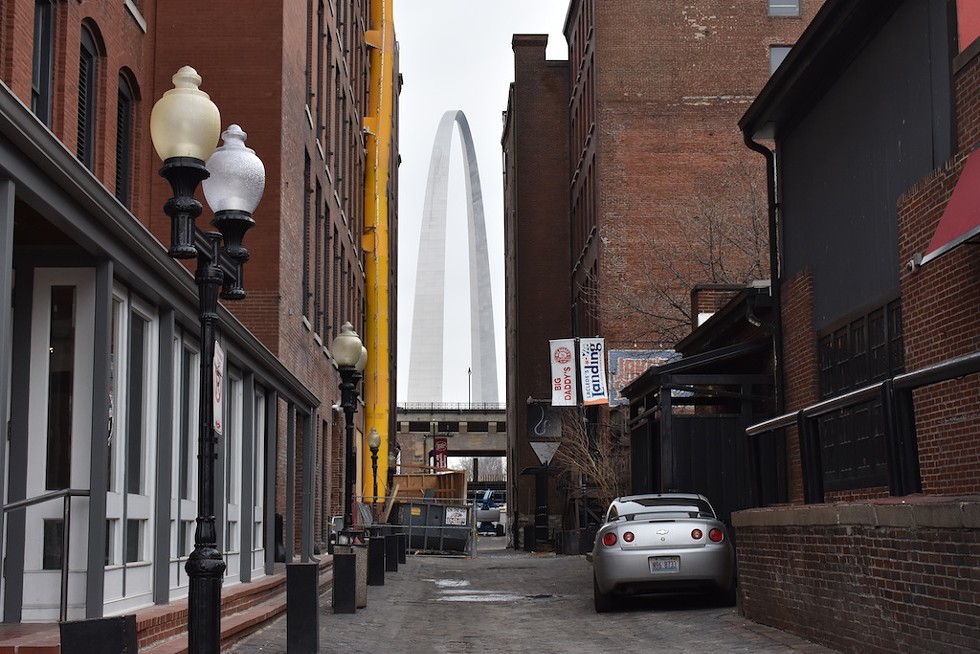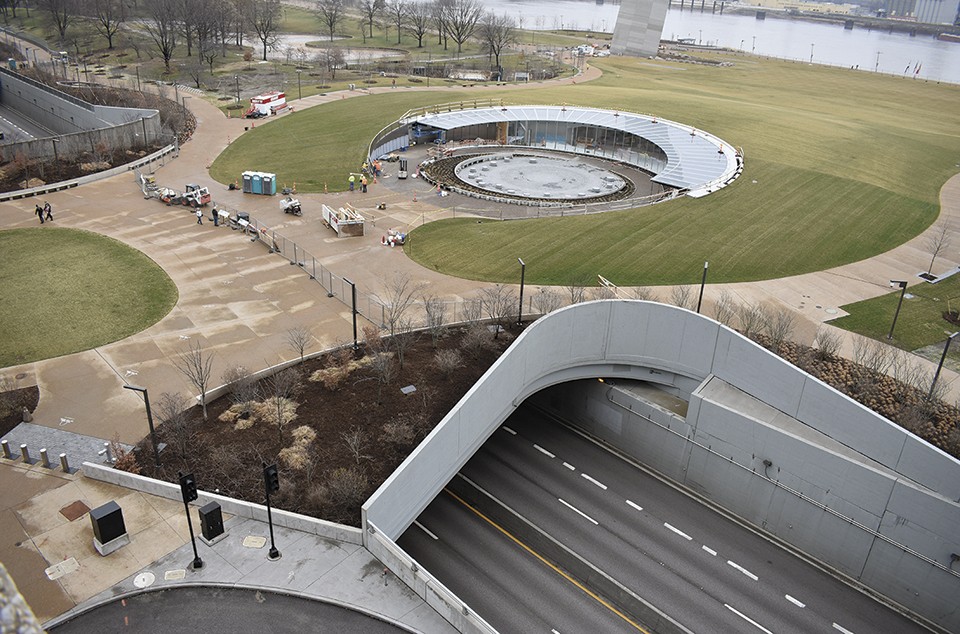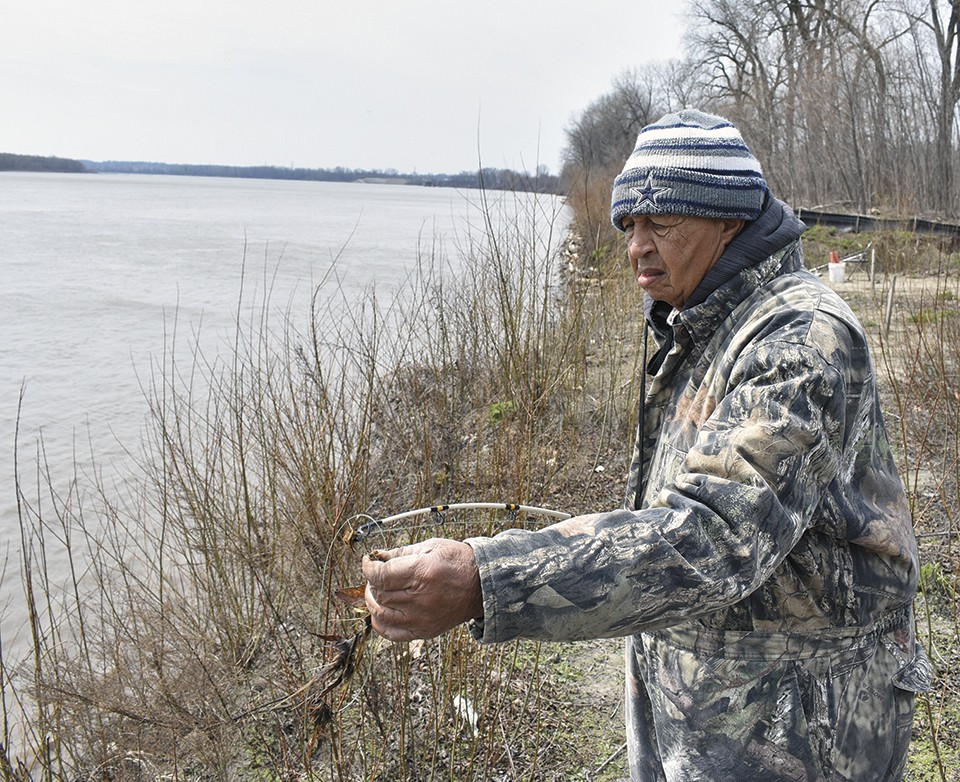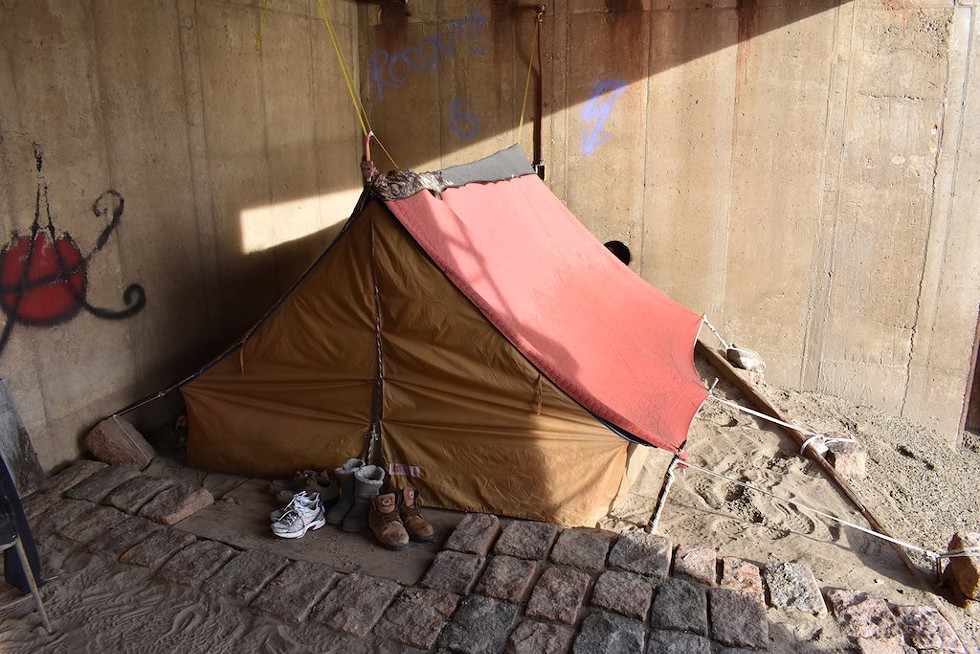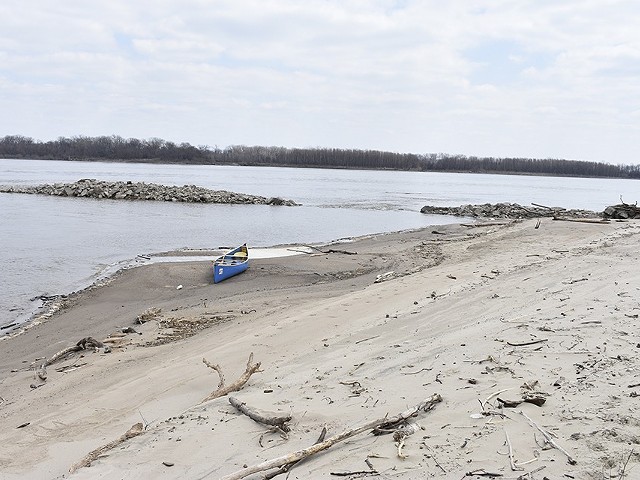On a cool, bright day in early April, one of the world's great rivers is deserted. No one fishing. No boats in sight. Flattened cans of malt liquor and a couple of cars had dotted the parking lot of North Riverfront Park, the drivers slouched down low in their seats. But out here in the middle of the channel, man has all but disappeared.
The dark, choppy water smacks against the side of the canoe. A steady wind whooshes overhead. In the distance, gleaming white pelicans bob alongside the Illinois shoreline. Is this the nightmare that has kept generations of St. Louisans clinging to high ground?
Well over a century after Mark Twain described the Mississippi River as a "wonderful book" with a "new story to tell every day," most of us barely think about it at all. The river remains a static monster in a forgotten corner of the city's psyche. Drive over it if you must, but don't get any closer than necessary. The Mississippi, St. Louis knows, will kill you if you let it. People do die in the waters every year — sucked under by a deceptively lazy-looking surface, fooled by shifting water levels that remake the banks without warning.
And yet, paddling toward the sandy beach of a river island just twenty minutes north of the Arch, it feels peaceful. An unseen canal diverts barge traffic around the Chain of Rocks. The occasional log floats past.
Paul Gruber steers this late-morning voyage from his seat at the rear of the bright blue canoe. The bearded 27-year-old moved to St. Louis from Florida for college, living here for years without ever really thinking about the river.
After studying graphic design, he worked in sales and construction. It was not until his then-boss suggested a Mississippi canoe and camping trip as a reward for his staff that Gruber even realized it was possible to get on the river.
"I didn't really have any outdoor skills," recalls Gruber, who as a kid didn't even like summer camp.
Still, he was interested in the idea. The trip was led by Mike "Big Muddy" Clark, the gruff philosopher king of a small band of river rats who dared dip their oars into the infamous waters. Clark was in the early stages of his guiding company, Big Muddy Adventures. The perceptions of the river were so negative back then he barely even considered marketing.
"Your first line would have to be, 'Try our service, you won't die,'" Clark, 58, says.
Instead, he focused on river evangelism. He was in search of converts — and more urgently, a cook — when he met Gruber on the overnight expedition about five years ago. Gruber had brought a pot of chili to help feed his co-workers, and Clark soon hired him to come along on future trips to handle the food. In the years since, the young paddler has spent thousands of hours traveling the river and camping along its banks. He has even done the end-to-end voyage, shoving off at the marshy headwaters in Minnesota and emerging 65 days later from the wide churn in Louisiana.
Not everyone takes to the Mississippi so completely, but it is also true that a growing number of people in the St. Louis area are taking a second look at the much-maligned river and seeing new possibilities. After years of ceding the waterfront almost entirely to industry, there are renewed efforts on a variety of fronts to bring city dwellers and tourists back to the water. New investment. Multi-million dollar projects.
For Clark, who has now taken thousands of people onto the river, just seeing St. Louis from the water provides an entirely different perspective.
"When people see the city from the river," he says, "they have this sense of pride."
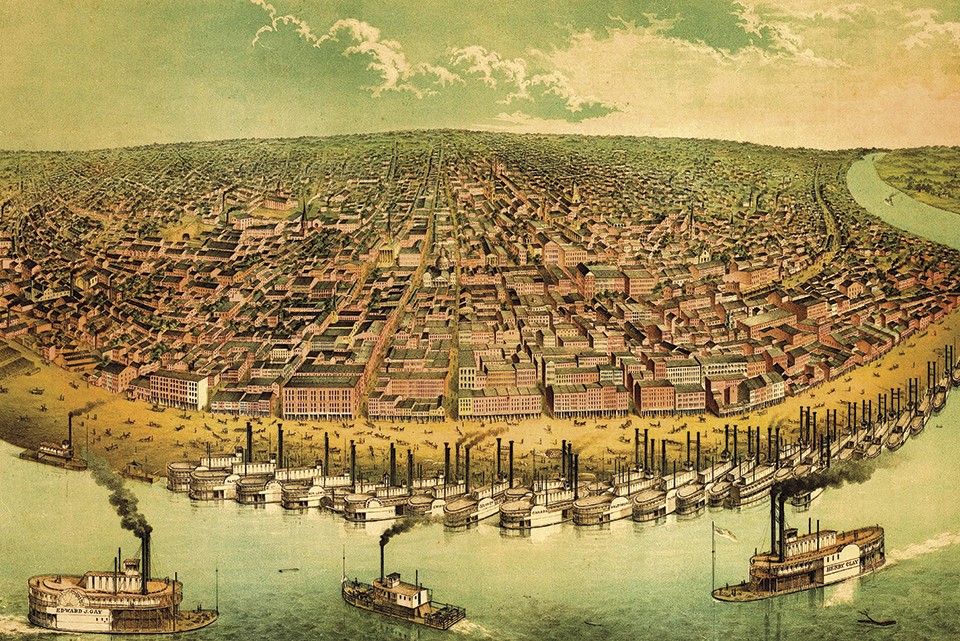
St. Louis' love-hate relationship with the Mississippi is almost as old as the city.
By the early 1800s, the settlement founded by French fur traders had begun to morph into a smoky, noisy industrial hub. The strategic location just south of the great river's confluence with the Missouri, paired with the rise of steamboats, made St. Louis a key inland port. Hundreds of buildings rose along the river's banks as we have tried simultaneously to harness its power and separate ourselves from it with flood walls, locks and overbuilt lowlands.
Over the years, the riverfront has supported shipbuilders, cotton merchants, lumber dealers, boilermakers and foundries for smelting iron ore hauled in from Missouri mines. Anheuser-Busch carved out a spot on the southern end where it could cool its beer in caves and ship product down the river.
Business boomed, but the grime of the factories and warehouses made for unpleasant living conditions, says David Lobbig, curator of environmental life at the Missouri History Museum. Wealthier residents fled polluted urban life for the countryside. The fact that the riverfront was the first stop for arriving immigrants only hastened the flight to the west.
"They moved further and further, and that tradition sort of continues today," says Lobbig, who is working on an upcoming exhibit about the middle Mississippi for the museum.
By the 1920s and 1930s, the riverfront had become a popular scapegoat for the city's flagging fortunes. Depression-era politicians described it as an irredeemable "slum" while floating a plan to demolish a 37-block zone. In its place, they vowed to build a grand memorial of some sort and new highways they promised would bring new life.
Historian and author Tracy Campbell argues the proposal probably had more to do with the interests of real estate firms, who were the largest property owners and stood to make a healthy profit by selling their buildings to the government through the eminent-domain process.
"Although some areas showed obvious signs of economic ruin, others were not quite the wasteland of destitute and abandoned buildings ravaged by time and the Depression that the mayor portrayed," he writes in The Gateway Arch: A Biography. In fact, the targeted zone included 290 businesses with a workforce of roughly 5,000 and only a two percent vacancy rate, Campbell notes. There were also nearly 200 houses, the majority of them rentals, charging middle-class rates.
Supporters of demolition leveraged the fact that a significant number of the people who lived there were black. They tried to persuade white voters that displacing residents and businesses would be best for the city as a whole.
In the end, Campbell writes, the campaign succeeded through a combination of unsupported promises, fear and widespread voter fraud. The Arch was eventually built on the site, but it never quite delivered the promised economic punch. And it did not erase the idea drilled into voters that the riverfront was a frightening and undesirable place.
Even today, with a $380 million overhaul of the Arch grounds scheduled for a full unveiling in July, elements of the old sentiment remains. The river is seen as dirty, dangerous and not a place for recreation. Alderwoman Christine Ingrassia says she learned as a kid in St. Louis never to trust the Mississippi.
"We were taught to be scared of it," she says.
It was only later, as an adult interested in environmental and flooding issues, that she first went onto the river. She was instantly hooked.
"I felt this sense of pure joy and excitement," she says, "and also regret that I was almost 40 years old and had never been out on the river before and had never really thought about the river before."
Munsok So's fourth-floor office has one of the best views anywhere in the city.
The east-facing windows of the prolific restaurateur's building on Laclede's Landing overlook the Mississippi from high above the water, the scene framed in stunning fashion by two historic bridges. He does not even have to turn his head to see the spans of the Eads Bridge to his right and the Martin Luther King Bridge to his left.
St. Louis' riverfront has always been a bit of mystery to So. When he travels to other cities, the hottest properties are along the water, regardless of whether that water is an ocean or creek. He never understood why the same was not true here.
"It puzzles me," he says.
The Landing, with its cobblestone streets and handsome brick buildings, is one of the few riverfront neighborhoods with open views of the water. Yet it has struggled. Over the past several years, So has seen neighboring bars in the once-thriving entertainment district dry up and die. Many blamed construction on the new Gateway Arch National Park for further isolating the hard-to-reach neighborhood. But So survived and is now poised to take advantage of his perseverance.
"The Landing itself needs to move with the times," he says. "All the bars and nightclubs that went out need to be re-concepted. The Landing is not what it was ten to fifteen years ago."

For one thing, the renovation of the Arch grounds included demolition of an eyesore of a parking garage that previously blocked the flow of foot traffic between the monument and the historic neighborhood. Gently winding paths curving along the new green space now funnel directly under the Eads onto the Landing's cobblestones. So's building at 612 North Second Street is the first structure pedestrians see upon entering the neighborhood.
"This was a dead-end zone," he says. "Now it's the front entry to the Landing."
He took advantage of the construction years to overhaul the 158-year-old former cutlery factory, focusing on a new clientele and much more river-centric concept. Instead of twenty-somethings arriving for nocturnal debauchery at bars and nightclubs, he sees a future full of families strolling over from the Arch grounds, weekend wedding parties and lunch-hungry employees from the surprising number of office workers in the historic neighborhood.
He is replacing his first-floor Drunken Fish sushi restaurant with a new fast-casual Korean spot called Kimchi Guys, due to open within weeks. A coffee shop called Miss Java will offer Belgian waffles and provide the neighborhood with a rare breakfast option — a nearly unthinkable concept when 3 a.m. bars ruled the Landing.
So's $3 million renovation calls for additional offices for lease and three new event spaces, including a 325-seat hall called VUE at the top of the five-story building. Like his office, the large event space has river views to the east, but the demolition of the parking garage has also opened a clear, southern sight line to the Arch and surrounding green space. Westward-facing windows look out on the city skyline. The newly opened space has already been booked for 40 events and weddings this year.
So sees all this as a natural evolution for the Landing and the city's riverfront as a whole. He thinks the combination of projects might finally bring St. Louis back to the Mississippi.
"Why couldn't we have a river market?" he says. "A thriving river market."
The Arch itself remains a marvel. A shimmering behemoth, it catches the light so easily from all angles that it can completely change its complexion within minutes. The site it sits upon, however, was flawed from the start.
Early planners had total and disastrously misguided faith in highways to jump start downtown. As a result, a wide interstate was routed along the western edge of the new monument's grounds. The placement has allowed untold numbers of commuters to call out "there's the Arch" as they cruise past, but it severed the site from downtown foot traffic as thoroughly as if it had been a moat. The ambitious tourist could still find his way from Busch Stadium or the Old Courthouse to the legs of the Arch (and maybe even down to the Mississippi), but the hassle seldom seemed worth it for most St. Louisans.
When the opportunity arose to renovate the 53-year-old monument's home turf, one of the primary objectives was to reconnect the park to downtown. Re-imagining the site has been a $380 million endeavor, with $221 million in private funding — the biggest public-private investment in a national park in history.
On a recent tour, Gateway Arch Park Foundation Executive Director Eric Moraczewski leads the way over a new land bridge toward the mouth of the re-imagined museum.
"You had all these roads you had to cross before you could even think of getting to the park," says foundation spokesman Tom Nagel.
The museum, scheduled to open in July, is state of the art. Interactive exhibits augmented by eleven-by-seventeen-foot video monitors will guide visitors through the rich history of how St. Louis shaped the country. Designers have worked to tell the story through a variety of perspectives — "The West was won" versus "The West was stolen," for example.
"It opens discussion," Moraczewski says. "It opens the thought process of how we got here and where are we going."
Visitors will descend through the underground space before re-emerging beneath the legs of the Arch. From there, they have eleven new acres of park to explore, aided by more than five miles of bike and walking trails. A bowl-shaped natural amphitheater has replaced the demolished parking garage, and the eastern edge of Pine Street provides another pedestrian walkway back into downtown.
From the eastern hillside, it is an easy walk down to the riverfront. In anticipation of the Mississippi's fluctuating water levels, which can rise and fall more than 40 feet, the park renovation raised Leonor K. Sullivan Boulevard two-and-a-half feet. The move is expected to prevent about 60 percent of the flood days when the river crests the road.
Now, they just need the people. The park foundation has already begun a series of concerts and events to draw crowds as they unveil the project in phases. The main welcome-back party is set for July at Fair St. Louis, when thousands of people are expected fill the grounds. Moraczewski wants people to see it as more than a tourist attraction.
"It's still a beautiful park," Moraczewski says. "We want it to be used like Forest Park or Tower Grove."
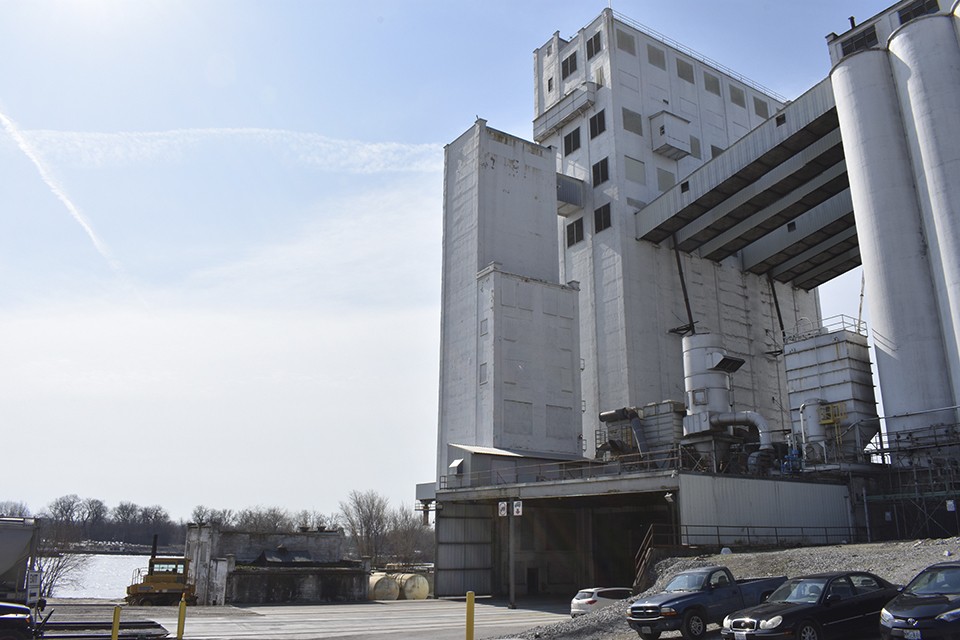
Night and day, barges chug along the Mississippi. The metro region still has one of the busiest inland ports in the country, and miles of the riverfront are occupied by industry.
"It truly is a working river down here," says Jim Meyer, president of Italgrani USA.
Headquartered along the water in deep south city's Patch neighborhood, the grain-milling operation blends a variety of specialty flours to ship to pasta makers across the country. The nearly century-old elevator was once among the tallest structures in St. Louis, and steelworkers are busy on the south end, building an addition that will increase Italgrani's storage capacity by 40 percent.
In years past, long lines of trucks hauled grain from farmers to the site where it could be milled, transported on a conveyor over to the river and poured onto barges bound for the gulf. Today, Italgrani is more likely to ship its products on rail cars, but it keeps its conveyors in working order for the occasional barge loading.
All along this strip of waterfront are commercial work yards, a nearly unbroken stretch until you reach Sister Marie Charles Park and Bellerive Park on the north end of Carondelet. Some of the businesses are like Italgrani and want or need access to the Mississippi, while others have taken advantage of affordable real estate in an industrial zone. Sarah Wood Martin, alderwoman of the Eleventh Ward, says fewer of her constituents make a living at the river than previous generations. A few of the big employers, including shipbuilders, have folded up, and automation has claimed other jobs.
"It's sad, because a lot of my constituents, their families were blue-collar and were able to make a living," Martin says. "But they're fourth generation, and it's almost like it's passed them by."
In the vacuum left behind, the stretch of south St. Louis along the river from Patch to Carondelet has begun to look for new ways to reinvent itself. The neighborhoods have attracted a growing arts scene, lured by affordable real estate and laid-back residents who, after living next to plants with 24-hour truck traffic, aren't likely to get too upset if a newcomer colors outside the lines a bit. The result is a mostly harmonious, free-wheeling mixture of factories, bars, community gardens, antique shops and murals.
"You have more leeway and more creativity because it's a lot of industry," Martin says. "I would like to see a nice entertainment district here."
A series of full-wall murals commissioned by the Carondelet Community Betterment Federation are part of that effort to rebrand. Fred Hessel, the federation's executive director, sees a lot of potential as real estate prices rise in trendier neighborhoods.
"This is a place where you can still buy an affordable house — not like Tower Grove South or Shaw," he says.
Martin agrees, though she says it is a place sometimes overlooked by the rest of the city, despite its charms.
"This is kind of this pocket," Martin says of her ward. "They really don't know it's there."
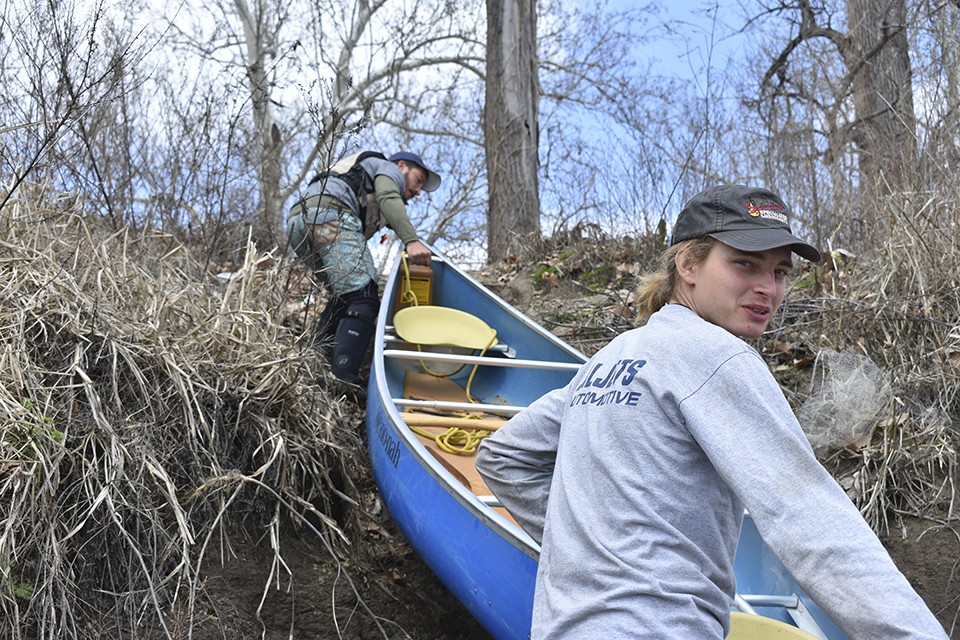
The Mississippi is not an easy river.
It is not, for example, a place for a mindless, boozy float trip. Clark from Big Muddy Adventures cautions novices against paddling out without a guide and the right gear. What might look like a single flow is really a patchwork of currents, ricocheting downstream as they slide over and under one another with boat-flipping power. Low waters that suck away from the banks one week might surge the next and cover previously dry land in wide pools. This is true even as engineers have tried to restrain the Mississippi's wilder tendencies. But usually, we do not get that close.
The abundance of fenced-in factories can make even getting to the water difficult. And while it is not the toxic sludge some might imagine, the idea of accidentally catching a mouthful of the Big Muddy is not exactly appetizing.
"Access to the river is really difficult," says Susan Trautman, CEO of Great Rivers Greenway. "I think that's why you don't see as many people on the trail."
Great Rivers has built about fourteen miles of trails along the St. Louis riverfront to the north, with plans for more connections and additional park areas in hopes of improving access. Part of the challenge is logistics, and part is perception, the not-completely unwarranted idea that isolated stretches along the river can be dangerous.
As part of its campaign to attract more people to the trails, the public agency has hired private security to patrol it from Wednesday through Sunday so that people feel safe, Trautman says. It seems to have begun to work. In 2015, the agency set out a counter and recorded more than 38,000 people on the trail. Trautman says it is a rewarding ride. "I've seen wild turkeys and deer and all types of wildflowers," she says.
The route runs north from Chouteau all the way to Old Chain of Rocks Bridge, weaving along both sides of the flood wall. Toward the north end, 71-year-old Eddie Price has cut across the trail to the banks of the Mississippi and anchored three fishing poles in the ground. He once pulled a 76-pound catfish out of these waters, he says.
"Man that sucker came good," he says. "I had about twenty people come to the house for a fish fry."
On this day, the retired Florida sheriff's deputy has only hooked a couple of sturgeon, which he threw back. Still, there's something nice about sitting on the side of the mighty Mississippi on a sunny day.
"I love watching the river going down, down, down," Price says.
"There is a fascination with it — I will say that," Trautman says. "People love to look at it."
A few miles south, tucked away in an alcove of the flood wall, a 57-year-old man who gives his name only as Jeff has spent weeks doing just that. He lives in a tent next to a couple who six months before built the campsite floor out of scavenged cobblestones and driftwood. They have gone out for the day, but Jeff has stayed behind.
In a few days, he plans to go to a rehab facility in Springfield, Illinois. He says he was kicked out of a St. Louis homeless shelter months before for arguing with the staff. He has a black eye, and a finger on his right hand is purple.
"It's peaceful down here, man," he says. The water will inevitably rise up someday and overtake this spot, but it soothes the man for now. Barges glide past all day long as one of the most storied rivers in the world stretches out before him. "It's peaceful just to sit down here. I've had people who come down here from the streets and just want to sit down here. Not get drunk. Just sit here."




